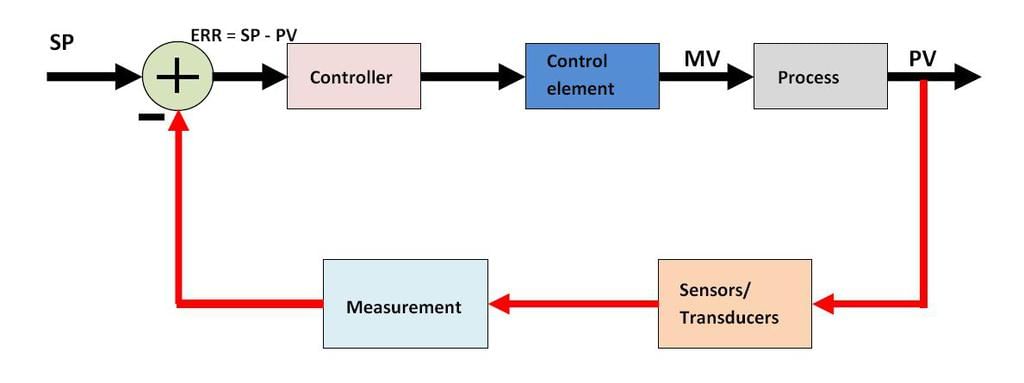Introduction to Transducers | Sensor & Industrial Instrumentation - Electronics and Communication Engineering (ECE) PDF Download
Introduction
The primary objective of process control is to control the physical parameters such as temperature, pressure, flow rate, force, level etc. The system used to maintain these parameters constant, close to some desired specific value is called process control system. These parameters may change because of internal and external disturbances hence a constant corrective action is required to keep these parameters constant or within the specified range.
The Fig. 9.1 shows the general arrangement of a process loop.
It consists of four elements:
(i) Process
(ii) Measurement
(iii) Controller
(iv) Control element Fig. 9.1 Process control loop
Fig. 9.1 Process control loop
For the proper feedback, it is necessary to measure the value of the actual parameter P. Most of the controllers are electronic in nature and hence require electrical input. Hence feedback signal required is in electrical form in most of the practical process loops. But actual parameter is temperature, pressure, level etc. Hence a device is required in the feedback path which will not only measure the output parameter but will produce proportional analog signal in the electric form. Many times the device is required to measure the physical parameter and produce the proportional signal which is also nonelectric such as pneumatic pressure. So in broad sense a transducer converts one form of energy to another form. But the electrical transducer produces an electrical signal proportional to the nonelectrical quantity to be measured. But as we are interested in the electrical instrumentation, a transducer can be defined as,
A device which converts a physical quantity into the proportional electrical signal is called a transducer.
The electrical signal produced may be a voltage, current or frequency. A transducer uses many effects to produce such conversion. The process of transforming signal from one form to other is called transduction. A transducer is also called pick up.
Actually, electrical transducer consists of two parts which are very closely related to each other. These two parts are sensing or detecting element and transduction element. The sensing or detecting element is commonly known as sensor.
Definition states that sensor is a device that produces a measurable response to a change in a physical condition.
The transduction element transforms the output of the sensor to an electrical output, as shown in the Fig. 9.2. Fig. 9.2 Transducer elements in cascade
Fig. 9.2 Transducer elements in cascade
The common range of an electrical signal used to represent analog signal in the industrial environment is 0 to 5 V or 4 to 20 mA. In industrial applications, now-a-days, 4 to 20 mA range is most commonly used to represent analog signal. A current of 4 mA represents a zero output and current of 20 mA represents a full scale value i.e. 5 V in case of voltage representation. The zero current condition represents open circuit in the signal transmission line. Hence the standard range is offset from zero.
Many a times, the transducer is a part of a circuit and works with other elements of that circuit to produce the required output. Such a circuit is called signal conditioning circuit.
Classification Of Transducers
A transducer is a device that receives energy from one system and transmits it to another in different form. Basically there are two types of transducers; namely electrical and mechanical. The mechanical transducers are those primary sensing elements that respond to changes in the physical condition of a system and gives output in different form. For example, when a bimetallic strip is subjected to a temperature change then the output is the mechanical displacement of the strip. The mechanical transducers are distinguished from the electrical transducers on the basis of the output signal generated. The mechanical transducers generate output signal which is mechanical by nature. The electrical transducers respond to non-electrical quantities but generate output signal which is electrical by nature. It is practically always possible to use either mechanical or electrical transducer for the measurement of any physical parameter. But it is observed that for each measurand, an electrical transducers are prefeied over the mechanical transducers.
The various advantages of electrical transducers are:
(i) Electrical signals can be easily attenuated or amplified and can be brought upto a level suitable for various devices, with the help of static devices FGK.
(ii) The power requirement of transducers is very small. The electrical systems can be controlled with a small level of power.
(iii) The electrical output of the transducer can be easily used, transmitted and processed for the purpose of measurement.
(iv) The reduced effects of friction and other mechanical nonlinearities.
(v) Due to the integrated circuit technology, the electrical and electronic systems are compact, having less weight and portable.
(vi) The data transmission through mechanical means is eliminated. Thus no mechanical wear and tear and no possibility of mechanical failures exist.
(vii) The reduced effects of mass inertia problems.
In general the electrical transducers are classified according to their structures, application area, method of energy conversion, output signal nature etc. Thus the electrical transducers are classified.
(i) As active and passive transducers,
(ii) On the basis of transduction principle used,
(iii) As analog and digital transducers,
(iv) As primary and secondary transducers, and
(v) As transducer and inverse transducer.
Characteristics Of Transducers
(i) Accuracy: It is defined as the closeness with which the reading approaches an accepted standard value or ideal value or true value, of the variable being measured.
(ii) Ruggedness: The transducer should be mechanically rugged to withstand overloads. It should have overload protection.
(iii) Linearity: The output of the transducer should be linearily proportional to the input quantity under measurement. It should have linear input - output characteristic.
(iv) Repeatability: The output of the transducer must be exactly the same, under same environmental conditions, when the same quantity is applied at the input repeatedly.
(v) High output: The transducer should give reasonably high output signal so that it can be easily processed and measured. The output must be much larger than noise. Now-a-days, digital output is preferred in many applications.
(vi) High stability and reliability: The output of the transducer should be highly stable and reliable so that there will be minimum error in measurement. The output must remain unaffected by environmental conditions such as change in temperature, pressure, etc.
(vii) Sensitivity: The sensitivity of the electrical transducer is defined as the electrical output obtained per unit change in the physical parameter of the input quantity. For example, for a transducer used for temperature measurement, sensitivity will be expressed in mV/°t. A high sensitivity is always desirable for a given transducer.
(viii) Dynamic range: For a transducer, the operating range should be wide, so that it can be used over a wide range of measurement conditions.
(ix) Size: The transducer should have smallest possible size and shape with minimal weight and volume. This will make the measurement system very compact.
(x) Speed of response: It is the rapidity with which the transducer responds to changes in the measured quantity. The speed of response of the transducer should be as high as practicable.
 |
Download the notes
Introduction to Transducers
|
Download as PDF |
Choice Of Transducers
Picking the right transducer for a given measurement application involves considering the transducer's characteristics, desired system performance, and input requirements. Because there are so many kinds of transducers, proper selection requires careful consideration.
(i) Nature of measurement: The selection of transducer will naturally depend upon the nature of quantity to be measured. For example, for temperature measurement, temperature sensors will be used; for measuring stress or strain, strain gauges will be utilized.
(ii) Loading effect: If the transducer in any way affects or changes the value of the parameter under measurement, errors may be introduced. The transducer is selected to have minimum loading effect to keep the errors to minimum.
(iii) Environmental considerations: A careful study be made of the conditions under which a transducer is expected to give satisfactory output. The troublesome aspects of the transducer location are the temperature changes, shock and vibration, and electromagnetic interference.
To minimize the errors due to temperature changes, some transduces are temperature compensated. For operation of transducer beyond 300° F, such temperature compensation becomes extremely difficult to design, and special materials are used for the transducer internal construction and bonding.
It is often very difficult to eliminate completely the errors due to shock and vibration. To have these errors as minimum as possible, transducers should be selected with a minimum movable mass in the sensing mechanism. Proper damping may extend the range of a transducer's usefulness under high shock and vibration conditions.
Transducers are often required to operate in the presence of varying strong electromagnetic fields. Transducers with low output impedance, high output voltage, and short cable length are less susceptible to such interferences.
Other considerations for transducer environments include:
(a) Simplicity of mounting and cable installation,
(b) Convenient size, shape and weight,
(c) Resistance of corrosion,
(d) Accessibility of the transducer for later repairs.
(iv) Measuring system compatibility: The transducer selected and the electrical system used for measurement should be compatible. The output impedance of the transducer and the impedance imposed by the measuring system must be such that one does not adversely affect the other.
(v) Cost and availability: General factors involved in selection are cost, availability, basic simplicity, reliability, and low maintenance. While selecting transducers of comparatively equal merits for a given application, the one that is most simple in operation and contains minimum number of moving parts would usually be selected. Transducers are selected which do not require excessive repair or continuous calibration checking. The selection of a transducer for a given application is normally a compromise between a number of factors discussed above.
Passive Transducers
In electrical circuits, there are combinations of three passive elements : resistor, inductor and capacitor. These three passive elements are described with the help of the primary parameters such as resistance, self or mutual inductance and capacitance respectively. Any change in these parameters can be observed only if they are externally powered. We have studied that the passive transducers do not generate any electrical signal by themselves and they require some external power to generate an electrical signal. The transducers based on variation of parameters such as resistance, self or mutual inductance capacitance, due to an external power are known as passive transducers. Hence resistive transducer, inductive transducer and capacitive transducer are the basic passive transducers.
|
23 videos|24 docs|29 tests
|
FAQs on Introduction to Transducers - Sensor & Industrial Instrumentation - Electronics and Communication Engineering (ECE)
| 1. What is a transducer? |  |
| 2. What are the applications of transducers? |  |
| 3. How do transducers work? |  |
| 4. What are the different types of transducers? |  |
| 5. What are the advantages of using transducers? |  |



























